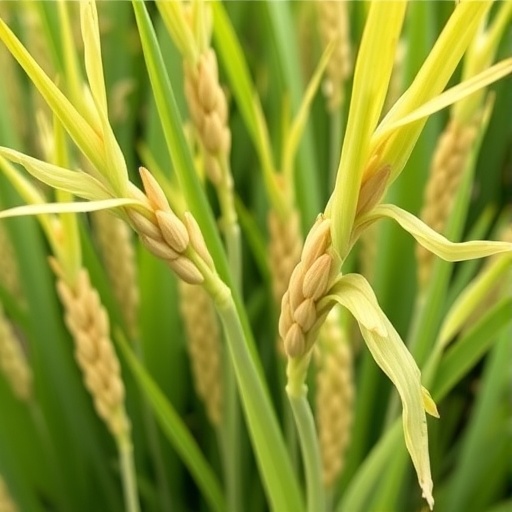In the realm of plant biology and agricultural innovation, the phenomenon of seed shattering holds pivotal significance. Seed shattering, the natural detachment of mature seeds from the parent plant, is an essential evolutionary strategy that enables wild plant species to disperse their progeny efficiently, ensuring survival and propagation in diverse ecosystems. However, in staple crops such as rice (Oryza sativa), seed shattering presents a double-edged sword: while it facilitates natural reproduction, it simultaneously contributes to substantial yield losses during mechanical harvesting. Addressing this inherent agricultural challenge has become a prime objective for researchers aiming to secure global food production amid growing demand and evolving farming technologies.
A landmark study recently unveiled by a team of Chinese scientists marks a significant stride in this endeavor. Their research, published in the Journal of Integrative Agriculture, centers around the targeted manipulation of a transcription factor named SHAT2, which belongs to the APETALA2/ethylene responsive factor (AP2/ERF) superfamily. This transcription factor has now been characterized as a crucial positive regulator that orchestrates both seed shattering dynamics and seed quality attributes in rice, unveiling a novel genetic gateway toward improving crop resilience and productivity.
The researchers embarked on an extensive functional genomics approach employing the CRISPR-Cas9 gene-editing platform to engineer precise mutations within the SHAT2 locus. By screening a transgenic library derived from the elite Wuyunjing 7 rice cultivar, they identified multiple allelic variants termed shat2 mutants. These mutants exhibited a remarkable alteration in seed shattering behavior alongside significant changes in grain quality parameters, implicating SHAT2 as a dual-function regulator with profound agronomic implications. The gene-editing strategy underscores the power of modern molecular tools to dissect and remodel complex phenotypic traits governed by transcriptional networks.
Detailed molecular analyses revealed that SHAT2 is ubiquitously expressed across a spectrum of rice organs, as demonstrated by real-time quantitative PCR assays. Its expression pattern suggests a multifaceted role beyond seed shattering, potentially integrating developmental cues and environmental signals to fine-tune seed maturation processes. At the gene regulatory level, the loss-of-function shat2 mutants manifested marked downregulation of several downstream genes intimately involved in cell wall modification, abscission layer formation, and grain filling. This transcriptional repression highlights SHAT2’s central position in a hierarchical network controlling seed detachment and quality formation pathways.
Seed shattering is contingent upon the precise formation and mechanical weakening of the abscission zone—a specialized tissue at the seed-pedicel junction that facilitates seed release upon maturity or mechanical force. The modified seed shattering phenotype observed in shat2 mutants was closely linked to disruptions in the cellular architecture and enzymatic activity within this abscission layer. These findings suggest that SHAT2 modulates the expression of key cell wall remodeling enzymes, such as polygalacturonases and cellulases, critical for orchestrating abscission layer dissolution. By fine-tuning such processes, SHAT2 enables an optimal balance between seed retention during crop cultivation and natural seed dispersal mechanisms.
Equally compelling are the implications of SHAT2 activity on grain quality—a parameter encompassing physical characteristics such as grain size, weight, and texture, along with biochemical traits including starch composition and nutrient content. The allelic mutants exhibited modifications in these quality metrics, implicating SHAT2 in coordinating developmental programs that influence grain filling and maturation. This coupled regulation of seed shattering and grain quality elevates SHAT2 as a promising target for molecular breeding, enabling the simultaneous improvement of harvesting efficiency and nutritional value.
Future research directions emphasized by the authors include an integrative analysis of SHAT2’s regulatory network through genome-wide binding assays, transcriptomic profiling, and proteomic studies to elucidate its downstream targets and interacting partners. Such comprehensive characterization will pave the way for precision breeding approaches aimed at engineering rice varieties with tailored seed shattering thresholds and enhanced grain characteristics, catering to the demands of mechanized agriculture and consumer preferences.
The emergence of CRISPR-Cas9 gene editing as a principal method in this study also exemplifies the transformative impact of genome engineering in crop science. Unlike conventional breeding, which often entails lengthy selection cycles and limited allelic diversity, targeted gene editing accelerates the generation of functional variants with predictable phenotypic outcomes. This approach not only expedites trait introgression but also alleviates concerns related to transgenic modifications, aligning with regulatory frameworks favoring gene-edited crops.
In the broader context of global food security, optimizing seed shattering traits through molecular interventions such as those involving SHAT2 is crucial to minimize post-harvest losses, augment yield stability, and support the scalability of rice production systems worldwide. Given rice’s status as a primary calorie source for over half of the world’s population, advancements in genetic resistance to seed shattering embody a vital component of sustainable agricultural development and climate adaptation strategies.
Furthermore, integrating SHAT2-focused breeding programs with other agronomic traits such as disease resistance, drought tolerance, and nutrient use efficiency holds tremendous promise in fostering climate-resilient rice cultivars. The study serves as a paradigm illustrating the nexus between fundamental plant biology, innovative gene editing technologies, and practical breeding applications aimed at addressing pressing challenges in crop improvement.
In summary, the elucidation of SHAT2’s role as a master regulator integrating seed shattering and grain quality pathways heralds a new chapter in rice genetic research. The targeted editing of this transcription factor opens avenues for creating rice varieties that maintain a delicate equilibrium between seed retention and release, optimizing harvestability without compromising grain excellence. The prospective deployment of these findings in breeding platforms will distinctly elevate rice productivity and quality, contributing meaningfully to global food sustainability and agricultural modernization.
Subject of Research: Cells
Article Title: Editing of the APETALA2/ethylene responsive factor confers improvements in seed shattering and quality in rice
Web References: DOI: 10.1016/j.jia.2025.02.022
Image Credits: Qian Qian, et al
Keywords: Agriculture, Plant sciences, Cell biology, Microbiology, Genetics
Tags: agricultural innovation and technologyCRISPR-Cas9 gene editing in agriculturecrop yield improvement strategiesenhancing seed quality traitsenvironmental adaptation in agricultureevolutionary strategies in plant reproductiongenetic manipulation in riceplant resilience and productivityseed shattering geneticsSHAT2 gene rice researchstaple crop yield lossestranscription factors in plant biology




